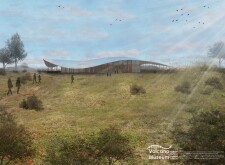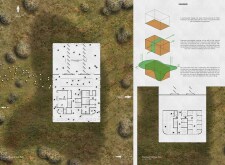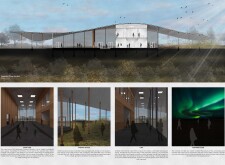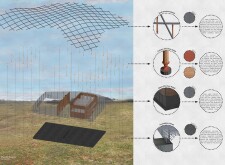5 key facts about this project
Functionally, the Volcano Museum is intended to serve multiple purposes. It will house exhibition halls dedicated to showcasing interactive displays about geological phenomena and the cultural narratives that intertwine with the volcanic landscape. Furthermore, the inclusion of social spaces such as a café allows visitors to engage not only with the exhibits but also with one another, thereby enhancing the communal aspect of the museum experience. The thoughtful arrangement of spaces promotes exploration and discovery, fostering a relationship between visitors and the natural world that surrounds them.
The architectural design reflects the features of the Icelandic landscape, with an engaging roofline that mimics the rolling shapes of volcanic formations. This wavy roof is instrumental in creating a visual dialogue between the building and its environment, while also encompassing architectural strategies for natural ventilation and sunlight optimization. The glazed panels utilized in the design allow abundant natural light to penetrate the interior, creating warm and inviting spaces. These elements collectively promote an airy atmosphere that encourages visitors to linger and explore.
Critical details of the project can be seen in its material palette, which has been carefully chosen to resonate with local conditions. Sustainable wooden elements sourced from regional timber not only serve as structural components but also add warmth and offer visual continuity with the surrounding ecosystems. The integration of steel and reinforced concrete provides essential stability, ensuring that the museum is resilient to the region’s geological dynamics. These materials not only support structural integrity but also reflect a respect for local craftsmanship and resources.
Unique design approaches are evident throughout the project, especially in the relationship established between the indoor exhibits and the outdoor surroundings. The incorporation of external spaces allows visitors to experience the natural landscape directly, making the museum a bridge between education and nature. Through careful landscape integration, the architectural design is attentive to the flow of space, inviting visitors to transition seamlessly between indoors and outdoors. This approach enhances the learning experience, as it encourages exploration of both the museum's exhibits and the surrounding geological features.
The Volcano Museum ultimately embodies a commitment to sustainability and environmental mindfulness. By utilizing local materials and designing for minimal environmental impact, the project addresses contemporary concerns about ecological stewardship. The thoughtful articulation of form and space creates a sense of place that acknowledges and celebrates the inherent beauty of Iceland's volcanic terrain.
For a more comprehensive understanding of the project, including architectural plans, sections, and design ideas, potential visitors and stakeholders are encouraged to explore the detailed presentation of the Volcano Museum. By doing so, one can gain deeper insights into the architectural concepts that define this unique endeavor in the heart of Iceland's stunning landscapes. The engagement with both cultural heritage and geological education makes this project a meaningful addition to the region, highlighting the dialogue between architecture and nature.


























